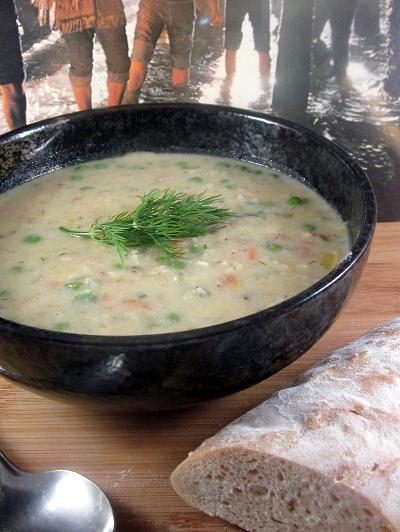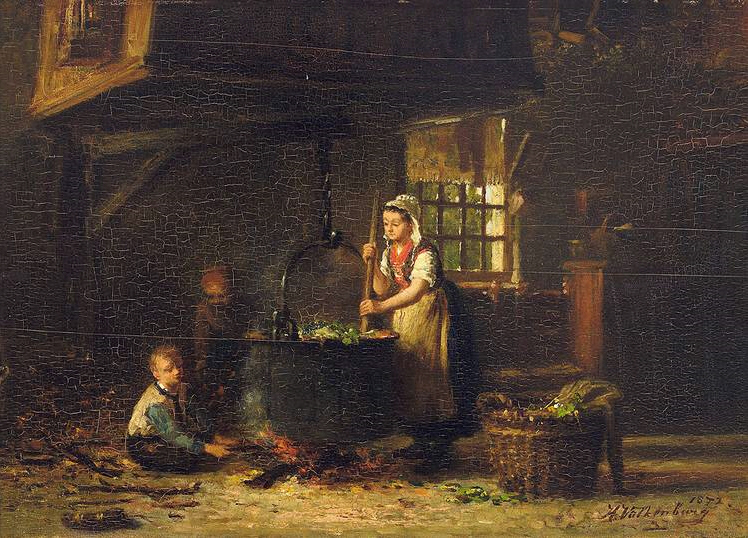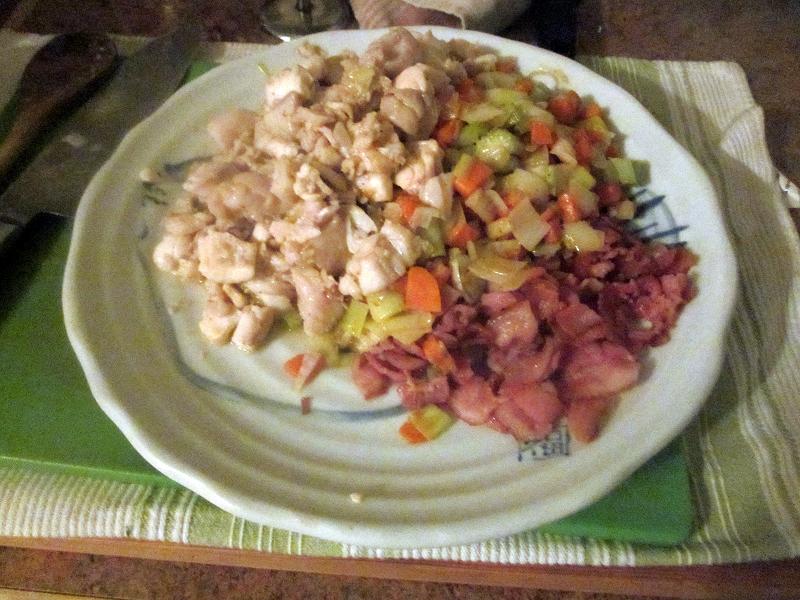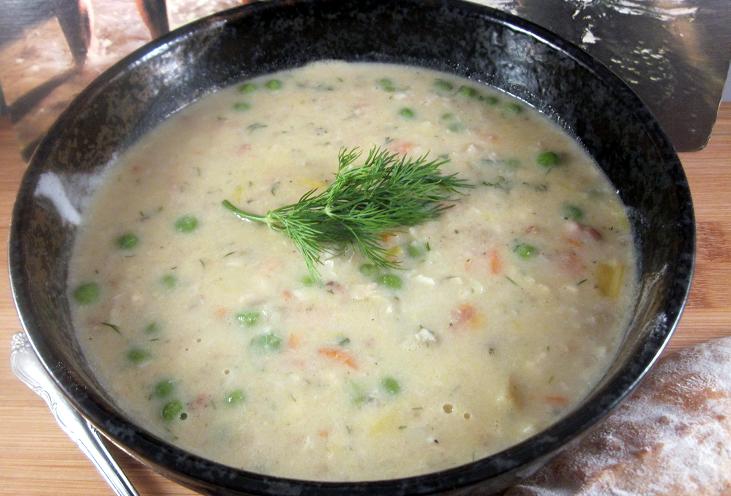 It’s amazing how much edible stuff you can squeeze out of one fish head! I’ve got the cheeks, a bowl full of meat scraped from behind the mantle and a big pot full of shimmering fish stock. It’s getting darn cold outside, so I’m going simple, rustic and warming by combining all these fishy bits into a hearty Westcoast Halibut Chowder.
It’s amazing how much edible stuff you can squeeze out of one fish head! I’ve got the cheeks, a bowl full of meat scraped from behind the mantle and a big pot full of shimmering fish stock. It’s getting darn cold outside, so I’m going simple, rustic and warming by combining all these fishy bits into a hearty Westcoast Halibut Chowder.
Our family makes these kinds of fish soup/stews all the time (Lisa’s Salmon chowder is the best!) and we’ve always referred to them as “Chowders”… But cooking this recipe got me thinking about that word and what really defines a chowder? Is it the fish? The potatoes? The cream? The little crackers tossed on top?
 If you scrye back into the murk of time via cookbooks and the internet you’ll find the French chaudière (a vessel used to cook a soup or stew) or chaudrée (a moistened fish casserole) cited as the root words, but bearing little resemblance to any of the soups we call chowders today. Equally justifiable roots can be dug up in Spanish and Portuguese. Even the old English word for a fishmonger is close, and the fish trimming-stews that they would frequently eat have a claim as the first chowders. What’s Cooking America.net has a great History of Chowder post with even more details
If you scrye back into the murk of time via cookbooks and the internet you’ll find the French chaudière (a vessel used to cook a soup or stew) or chaudrée (a moistened fish casserole) cited as the root words, but bearing little resemblance to any of the soups we call chowders today. Equally justifiable roots can be dug up in Spanish and Portuguese. Even the old English word for a fishmonger is close, and the fish trimming-stews that they would frequently eat have a claim as the first chowders. What’s Cooking America.net has a great History of Chowder post with even more details
I always figured that the use of potatoes as the primary thickener made a soup into a chowder. I’ve no idea who I heard that from, or why I believed it, but there it is. Every recipe I’d ever seen had spuds in it. Only a soup that was thickened with the natural starches in potatoes (or perhaps soaked biscuits!) and not a roux was the real deal… Or, so I thought.
I turned to my old splattered ‘n battered copy of the Prentice Hall Dictionary of Culinary Arts for the final word:
Chowder – A hearty soup made from fish, shellfish and/or vegetables, usually containing milk and potatoes and often thickened with a roux.
Well, looks like the voices in my head have once again led me astray. No problem, here on the Westcoast we play a little more fast ‘n loose with that definition than they do over in the Eastern Maritimes.
To give my chowder a nice velvety texture I’ve come up with an only slightly-more complex system of cooking than your average New England-style one pot wonder. It involves cooking everything in stages, setting them aside when they’re tender and combing them back together in the end.
I want the flavours to develop and remain in the bottom of the pot by the time the fish stock and potatoes are simmering together, ‘cause guess what? I’m not using a roux! Despite what my dictionary says! The spuds are finely pureed into the liquid, forming a smooth, savoury, not-gluey hot tub for the fish and vegetables to simmer away in. That bright idea came from the exhaustively researched recipe over at Serious Eats.
Halibut Chowder (Serves 4-6)
Ingredients
- 4 rashers of Bacon (approx. 125g, chopped)
- ½ Tbls. Butter
- 14 ounces of Halibut Trim (400g, taken from the head and chopped)
- 1 ½ cups of Leeks (160g, diced)
- ½ cup of Celery (40g, diced)
- ½ cup Carrots (85g, diced)
- ½ cup White Wine
- 4 Medium-Sized Yellow Potatoes (450g, diced)
- 6 cups Fish Stock (approx. 1.5L)
- 2 More Medium-Sized Yellow Potatoes (225g, diced)
- 2 ounces Heavy Cream (60ml)
- 2 Tbls. Fresh Dill (finely chopped)
- 1 Tbls. Fresh Parsley (finely chopped)
- ½ cup Green Peas (85g, frozen is fine)
- Salt and White Pepper
Method
- Fire up a large pot on low heat and dump in your bacon. Render the bacon, stirring occasionally for the next ten minutes. Grab a slotted spoon and remove all the solids from the pot, leaving all that delicious bacon fat behind. Drain the bacon solids on a piece of paper towel, and make sure to leave room on your plate, they’re going to have some company!

- Increase the heat to medium and melt the butter in the bacon fat (that’s officially the sexiest thing I’ve ever written!). Season the halibut trimmings with a bit of salt and white pepper and sauté them in the pot for 2 minutes. Transfer the trimmings from the pot to the plate and add the leeks, celery and carrots. Cook them for 4 minutes, stirring occasionally and once again transfer to your plate.
- Splash the white wine into the pot and scrape up any sticky bits clinging to the bottom. Add your stock and the first wave of potatoes, bring to a boil. Lower the heat to a simmer and cover for 10-12 minutes, we want the potatoes to be nice ‘n tender. Remove the pot from the heat and get out your handy immersion blender. Puree the stock and potatoes together.
- Return the pot to medium heat and dump in the next wave of potatoes. Cover and simmer for another 10 minutes. Add everything on the plate (ie. the bacon, trimmings, veg) back into the pot, re-cover and simmer another 5 minutes. Stir in the cream, dill, parsley, peas and seasonings. Keep it simmering for a final 5 and serve with some crusty bread, garnished with dill.

 Music To Cook This To:
Music To Cook This To:
The Best Of The Guess Who Vol.1